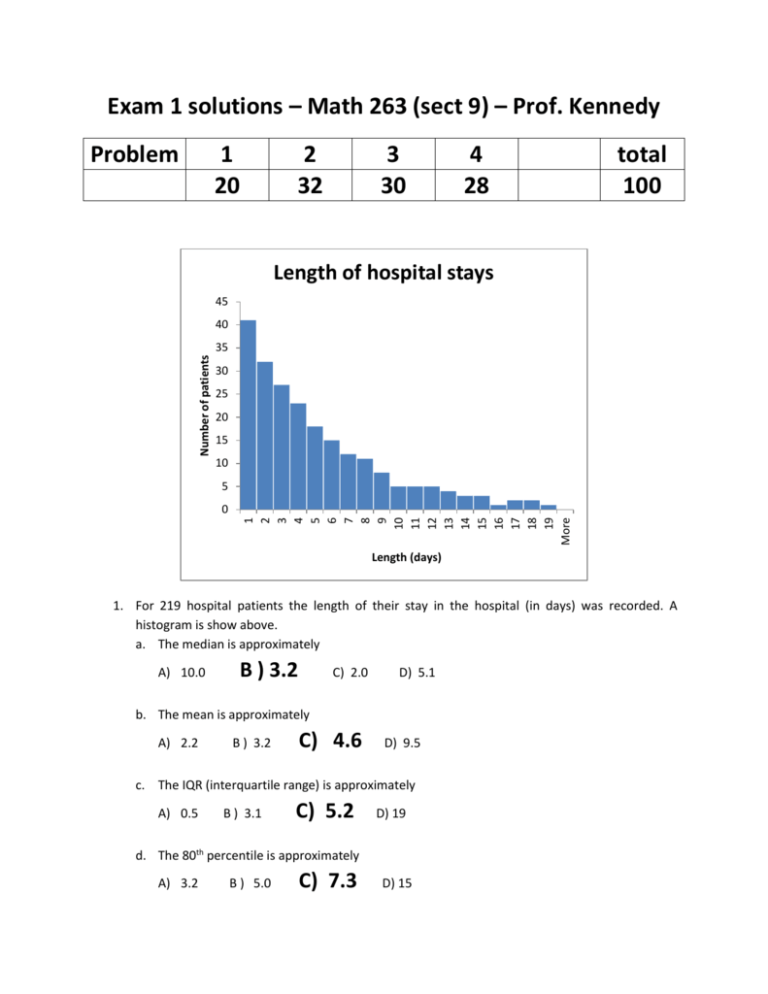Exam 1 solutions – Math 263 (sect 9)
advertisement

Exam 1 solutions – Math 263 (sect 9) – Prof. Kennedy Problem 1 20 2 32 3 30 4 28 total 100 Length of hospital stays 45 40 Number of patients 35 30 25 20 15 10 5 1 2 3 4 5 6 7 8 9 10 11 12 13 14 15 16 17 18 19 More 0 Length (days) 1. For 219 hospital patients the length of their stay in the hospital (in days) was recorded. A histogram is show above. a. The median is approximately A) 10.0 B ) 3.2 C) 2.0 D) 5.1 b. The mean is approximately A) 2.2 B ) 3.2 C) 4.6 D) 9.5 c. The IQR (interquartile range) is approximately A) 0.5 B ) 3.1 C) 5.2 D) 19 d. The 80th percentile is approximately A) 3.2 B ) 5.0 C) 7.3 D) 15 2. Assume that blood-glucose levels in a population of adult women are normally distributed with mean 90 mg/dL and standard deviation 38 mg/dL. a. Use the standard normal distribution to determine what percentage of the population has a level above 80 mg/dL Solution: Z=(80-90)/38= -0.263158 From table or calculator, probability below this is 0.39627. So answer is 10.39627=0.6037=60.37% b. The 90th percentile for glucose levels is the level such that 90% of the population has a glucose level lower than the 90th percentile. Find the 90th percentile for glucose levels. Solution:From table or calculator the 90th percentile for standard normal distribution is at z=1.2816. So answer is 90 + 1.2816*38 mg/dL =138.7 mg/dL c. Suppose that the “abnormal range” is defined to be glucose levels which are 1.5 standard deviations above the mean or 1.5 standard deviations below the mean. What percentage of individuals would be classified “abnormal?” Solution: This is same as asking what percentage of standard normal distribution is below z=-1.5 or above z=1.5. For standard normal the probability less than -1.5 is 0.0668. By the symmetry of the distribution the probability above 1.5 is the same. So answer is 2*0.0668=13.36%. d. Suppose we want to redefine the abnormal range to be more than c standard deviations above the mean or less than c standard deviations with c chosen so that 4 % of the population will be classified as abnormal. What should c be ? Solution: By symmetry there will be 2% below the mean minus c standard deviations. For the standard normal we must take z=-2.054 to have 2% of the probability to the left. So the answer is 2.054. 3. A sample was taken of the heights of 20 U of A students in inches. The following are the heights in increasing order. 55 69 59 70 60 71 60 72 62 73 64 74 66 74 67 75 67 77 68 78 a. What is the median height of the 20 students? 68.5 in b. What is the first quartile of the 20 heights? 63 in c. What is the interquartile range of the 20 heights? 73.5 in -63 in = 10.5 in d. These heights were in inches. Suppose we convert them to cm. (1 inch is 2.54 cm.) For each of the summary measures (statistics) in parts a,b and c find its value for the data in cm. a) 174 cm b) 160 cm c) 26.7 cm 4. A doctor has two different instruments for measuring the blood glucose level in mg/dL. For 8 patients he first measures their level with instrument A and then with instrument B. Patient A (mg/DL) B (mg/dL) 1 78 87 2 95 102 3 107 119 4 92 101 5 84 96 6 89 101 7 112 118 8 98 109 Treat the reading on instrument A as the explanatory variable and the reading on the B instrument as the response variable. a. Find the correlation coefficient r. Solution: Running the linear regression program in the calculator gives R=0.9778 b. Find the equation of the regression line. (B observation) = 0.937 (A observation) + 15.69 mg/dL c. Is it reasonable to conclude from this data that there is a casual relationship between the two tests? Explain your answer. (Note that casual should have been casual.) Solution: there is a very strong correlation (|r| is very close to 1), but we cannot conclude from this that the reading on instrument A is causing the reading on B. d. Use your regression line to predict what instrument B would read for a patient with a reading of 90 on instrument A. Solution: Plug in 90 in the equation in b. and you get a prediction of 100.02 mg/dL e. What are the units of the y-intercept in your regression line equation? mg/dL f. Give a one sentence explanation of what the value of the y-intercept in your regression line means. Solution: the fact that the value is relatively large and positive suggests that one or both of the instruments are out of calibration. The B instrument reads considerably higher than instrument A on average.






